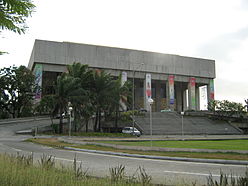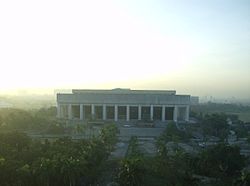- Manila Film Center
-
Manila Film Center 
The front exterior of the CenterGeneral information Location Pasay City, Manila, Philippines Coordinates 14°33′02″N 120°58′55″E / 14.550556°N 120.981944°ECoordinates: 14°33′02″N 120°58′55″E / 14.550556°N 120.981944°E Construction started 1981 Completed 1982 Cost $25 million (USD) The Manila Film Center is a national building located at the southwest end of the Cultural Center of the Philippines complex in Pasay City, Philippines. The structure was designed by architect Froilan Hong where its edifice is supported on more than nine hundred piles[1] which reaches to the bed-rock about 120 feet below. The Manila Film Center served as the main theater for the 1st Manila International Film Festival[2] (MIFF) from the 18th to the 29th of January, 1982. The building has also been the subject of controversies due to an accident that happened during the final stages of its construction in 1981.
Contents
History
Prior to the Manila film center, the Philippines did not have an official national film archive which is why on January 1981, then first lady Imelda Marcos spearheaded the building of the first Manila Center. Under the supervision of Mrs. Betty Benitez-the spouse of the then Deputy MHS Minister Jose Conrado Beneitez organized a group to pursue the project. Mr. Ramon M. Ignacio, Senior Technology Officer at the Technology Resource Center conceptualized the project and its various components. He likewise prepared the feasibility study. Among the Film Center's project components were the 360 degrees theatre that will show images of past and present historical and tourism scenes for the future generatios to see; the Film Financing/Loan Program that will address funding of meritable films, the Filipino Film Archiving using Digital Storage (was little known during those times); Film Database/Information system; Film Making and Blow Up Laboratory; Viewing rooms for the Board of Censors and other minor sub-components. However, despite the futuristic and concept creativity of Mr. Ramon M. Ignacio, only two of the project components were actually done. Unesco’s [3] assistance was invaluable in the design of the archives, so they were asked to be consultants of the project. Several ocular visits were done by Unesco in 1981 where they were responsible for major consultations needed in the structure’s erection. The building was then designed to have two components[3] which were the auditoria and archives. According to Architect Hong, the foundation was set on reclaimed[4] land near the Manila Bay. Since the deadline of the structure was tight, it required 4,000 workers, working in 3 shifts across 24 hours. One thousand workers constructed the lobby[5] in 72 hours, a job which would normally entail six weeks of labor. The Film Center opened in 1982 costing at an estimate of $25 million.
Accident
An accident occurred around 3:00 a.m. on November 17, 1981 during the construction of the Manila Film Center. Its scaffolding[6] collapsed,[5][7] and at least 169[5][8][9] workers fell and were buried under quick-drying[10] wet cement. A security blanket was immediately imposed by the Marcos administration, and neither rescuers nor ambulances were permitted[5] on the site until an official statement had been prepared. The rescuers were eventually permitted to go inside the accident site 9 hours after the collapse.
Aftermath
After the tragedy Prime Minister Cesar Virata disapproved a $5 million [5] subsidy which was originally intended for the film festival. Lacking in funding, Imelda then created a contingency plan that would generate enough funds to cover for the festival. A law was passed in the form of presidential decree 1986 (P.D. 1986) [11] which created a board of review for motion pictures and television, this entity was later known as Movie and Television Review and Classification Board[12] (MTRCB).This in turn relaxed censorship laws circumventing within the festival, this paved way for soft-porn films to be shown during the festival. P.D. 1986 also an exclusive exemption of film films shown at the Manila Film Center from censorship. Ultimately the building was finished in 1982 and on the opening night, the first film shown in the theatre was the movie Gandhi. The event was attended by Ben Kingsley who played Mohandas K. Gandhi in the movie. Other celebrities in attendance were Robert Duvall and George Hamilton with Imelda Marcos who wore on stage a Joe Salazar[13] black and green Filipiniana terno with a hemline filled with peacock feathers.
The First Manila Film Festival
Amidst everything the first Manila International film festival pushed through from the 18th to the 29th of January 1982. A total of 17 movies competed in the festival [5] namely 36 Chowringhee Lane (India), Body Heat (USA), Gallipoli (Australia), Growing up (Line Iida) (Norway), Harry Tracy-Desperado (Canada), La Femme d'à côté (France), Lola (Germany), Los Viernes de la Eternidad (Argentina), Majstori, Majstori! (Yugoslavia), No Charges Filed (Egypt), Smash Palace (New Zealand), Take It All (Jetz Und Alles) (West Germany), The Beloved Woman of Mechanic Gavrilov (USSR), The French Lieutenant's Woman (Great Britain), There Was A War When I Was A Child (Japan), Vabank (Poland) and Wasted Lives (Hungary). Eventually it was India’s entry, 36 Chowringhee Lane which would claim best picture while best actress and best actor were brought home by Lyudmila Gurchenko and Bruno Lawrence respectively. Yugoslav film director Goran Marković won best director.
Amazing Philippine Theatre
After the 1990 earthquake[14] that hit Manila and the rest of Luzon, the center was abandoned[15] due to the building becoming unstable. This was the state it was left with until 2001 when then CCP President Armita Rufino revealed a full rehabilitation program for the deteriorating building. Department of Public Works and Highways (DPWH) and the film center’s architect Hong was part of the strategic planning session on how the structure was to be renovated. The rehabilitation cost estimates in 2001 were approximately 300 million pesos[15] which was still considered economical rather than building a new one that would’ve cost 1.8 billion pesos. After its renovation was completed, CPACEAI[16] leased the theatre from the Philippine government in October 2001. On December 10, 2001, the amazing show[17] opened to the public with barely 3 months of rehearsal done. All of the women performing in the production of the amazing show are transgendered[18][19] and since the show began they have attracted more than 280,000 tourists. The show’s success translated to the Amazing Philippines Theater opening other regional shows, specifically in Boracay and in Cebu. In 2009 at the expiration of their lease, the Amazing Philippine Theatre which operates the amazing show finally vacated the Film Center, moving into another facility.
Future use
At the advent of the amazing show vacating the theater, the Philippine Senate [6] was the first entity to eye the facility for its use. Senate Majority floor leader Juan Miguel Zubiri confirmed that the senate has been negotiating with the officials of CCP on the feasibility of leasing the building for the upper chamber. Until the discussions, the Philippine senate has had a 120 million a year lease on the Government Service Insurance System (GSIS) building in Pasay City, the senate is located only a few meters away from the film center. During the negotiations however, Senator Aquilino Pimintel Aquino raised doubts[20] on housing the Senate in the theater and suggested that it would be better if both the upper and lower house’s were situated in one facility. Currently the house of representatives is situated in Quezon City but has also expressed its plans to transfer to Fort Bonifacio Global City.
Urban legend
The Manila Film Center is said to be haunted[21] due to the accident that took place in the construction of the structure. It has been stipulated that due to the 9 hours that passed before rescuers were allowed in the site, some of the workers were entombed alive[13] and that the bodies were left on the hardened concrete slabs. In a 2005 documentary produced by GMA Network’s i-Witness, all 169 workers were traced and the records show that not more than a dozen died. Furthermore all the bodies were retrieved and were given a proper burial.[citation needed]
In popular culture
In the 2010 Filipino film The Red Shoes, part of the plot hinges on the supposed death of the father of the main character, Lucas, played by Marvin Agustin, who was supposed to have been among the 169 workers buried alive in the accident at the construction of the Manila Film Center. The film also featured a spiritist, Madame Vange, played by Tessie Tomas who performs in the Manila Film Center as an impersonator of First Lady Imelda Marcos.
The in the graphic novel, The Filipino Heroes League, the building is portrayed as transformed from the Film Center to the FHL's headquarters. The building was once respectable and housed the old members of the League. After a while, their leader, Supremo, went into comatose and soon after, most of the superheroes who were once part of the League went abroad. Less than a handful of superheroes remain and continue to conduct their superhero work in a shack in front of the now run down Film Center.
See also
- Cinemalaya Philippine Independent Film Festival
- Cultural Center of the Philippines
- Manila Metropolitan Theater
- Philippine International Convention Center
References
- ^ "Manila National Film Centre, Page 2, Annex 1, Building Specification". Unesco. http://unesdoc.unesco.org/images/0004/000472/047235eo.pdf. Retrieved 2009-01-16.
- ^ "MIFF Press Release". Open Library, Published in 1982, Office of Media Affairs (Manila). http://openlibrary.org/b/OL3102691M/Manila_International_Film_Festival_January_18-29_1982.. Retrieved 2009-01-16.
- ^ a b "Manila National Film Centre, Page 1, Annex 1, History". Unesco. http://unesdoc.unesco.org/images/0004/000472/047235eo.pdf. Retrieved 2009-01-16.
- ^ "Manila Film Center Shines again". Philippine Headline News Online (Newsflash). http://www.newsflash.org/2001/02/sb/sb001587.htm. Retrieved 2010-01-18.
- ^ a b c d e f [|Lico, Gerard] (2003). Edifice complex: power, myth, and Marcos state architecture (edition (January 2003) ed.). HI: University of Hawaii Press; illustrated edition. pp. 124 of 178. ISBN ISBN 9715504353, ISBN 978-9715504355. http://books.google.com/books?id=D9LBPoIe-F4C&pg=PA269. Retrieved 2009-12-14
- ^ a b "Senate eyes Film Center as new home". Manila Bulletin. http://www.mb.com.ph/articles/222753/senate-eyes-film-center-new-home. Retrieved 2010-01-19.
- ^ "Where Spirits Roam". Rogue Magazine, October 2009 Issue.
- ^ "Shared Spaces of Transnational Transit: Filipino Gay Tourists, Labour Migrants, and the Borders of Class Difference". Bobby Benedicto, DOI 10.1080/10357820903153715. http://www.informaworld.com/smpp/content~content=a913860090&db=all. Retrieved 2010-01-19.
- ^ "Max Soliven: By the Way". Philippine Star. http://www.newsflash.org/2004/02/ht/ht006672.htm. Retrieved 2010-01-19.
- ^ "Sculpting Society". Philippine Daily Inquirer. http://opinion.inquirer.net/viewpoints/columns/view/20070610-70434/Sculpting_Society. Retrieved 2010-01-19.
- ^ "List of PD 1950-2000". Chan Robles Law. http://www.chanrobles.com/presidentialdecrees1951-2000.html. Retrieved 2009-01-18.
- ^ "Presidential Decree No. 1986". Chan Robles Law. http://www.chanrobles.com/presidentialdecrees/presidentialdecreeno1986.html. Retrieved 2009-01-18.
- ^ a b "Manila Film Center to Shine Again". Manila News. http://www.newsflash.org/2001/02/sb/sb001587.htm. Retrieved 2010-01-18.
- ^ "The July 16 Luzon Earthquake: A Technical Monograph". Inter-Agency Committee for Documenting and Establishing Database on the July 1990 Earthquake. Philippine Institute of Volcanology and Seismology. 2001. http://earthquake.phivolcs.dost.gov.ph/update_SOEPD/Earthquake/1990LuzonEQ_Monograph/foreword.html. Retrieved 2009-01-07.
- ^ a b "Manila Film Center Shines again". News Flash. http://www.newsflash.org/2001/02/sb/sb001587.htm. Retrieved 2010-01-18.
- ^ "Manila Film Center Shines again". Amazing Philippines Facts. http://www.amazing-show.com/FactSheet.pdf. Retrieved 2010-01-18.[dead link]
- ^ "Amazing Philippines Theatre". Lonely Planet. http://m.lonelyplanet.com/destinations/Manila/night/622357/g-641/d-622177/l-activity. Retrieved 2010-01-18.
- ^ "Amazing Philippine Theater comes to Boracay". The Philippine Daily Inquirer. http://showbizandstyle.inquirer.net/lifestyle/lifestyle/view/20070827-84840/Amazing_Philippine_Theater_comes_to_Boracay. Retrieved 2010-01-18.
- ^ "An Amazing night of beauties". The Manila Standard. http://telebisyon.net/balita/An-Amazing-night-of-beauties/artikulo/34652/. Retrieved 2010-01-18.
- ^ "Senate transfer to Film Center bucked". Manila Bulletin. http://www.mb.com.ph/articles/223336/senate-transfer-film-center-bucked. Retrieved 2010-01-19.
- ^ "Manila Film Center". Spot Ph. http://www.spot.ph/2009/10/30/10-scary-spots-in-metro-manila/5/. Retrieved 2010-01-18.
External links
Categories:- Landmarks in the Philippines
- Urban legends
- Philippine culture
- Reportedly haunted locations in the Philippines
- Paranormal places in the Philippines
Wikimedia Foundation. 2010.


